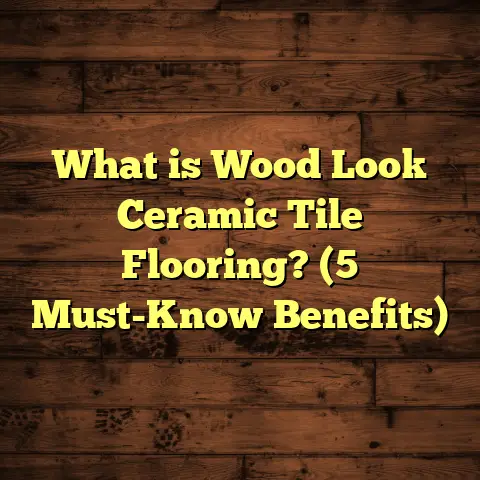What is Cork Flooring Made Of? (5 Key Benefits & Uses)
Cork flooring has been quietly rising in popularity, and I can see why every time I step into a home where it’s installed. More homeowners and designers are leaning toward materials that don’t just look great but feel good and make sense environmentally. Over the years, I’ve worked on many cork flooring projects, and each one has reinforced how versatile and smart this option can be. Let me walk you through what cork flooring is made of, how it’s made, the benefits I’ve witnessed firsthand, uses where it really shines, and even some honest thoughts about its limits.
How Cork Flooring Comes to Life: From Tree to Floorboard
You might already know that cork flooring is made from cork bark, but the full story behind how it goes from tree bark to the beautiful planks in your home is pretty fascinating—and crucial to understanding why cork is so unique.
Harvesting Cork Bark: The Renewable Raw Material
Cork comes from the bark of the cork oak tree (Quercus suber), native mainly to the Mediterranean region—Portugal being the world’s largest producer. What’s interesting is that harvesting cork doesn’t mean cutting down the tree. Instead, skilled harvesters strip the outer bark carefully by hand every 9 to 12 years.
The tree remains alive during and after this process because only the outer layer is removed, leaving the inner bark intact. This sustainable harvesting method means cork oak forests can be productive for over 200 years.
I have a client who visited Portugal and told me about watching these harvesters work—it’s almost like an art form. This sustainable approach is a huge selling point for many people.
Processing Raw Cork: From Bark to Granules
Once harvested, the cork slabs are boiled in water for about an hour or more. Boiling serves several purposes:
- It softens the cork, making it easier to cut and shape.
- It removes impurities like tannins.
- It expands the cork cells slightly, improving elasticity.
After boiling, the cork dries for a few weeks. Then it’s either sliced into sheets or ground into granules.
For flooring, these granules are mixed with adhesives to create composite products or used in their natural sheet form for tiles.
Manufacturing Cork Flooring: Types and Techniques
There are two primary methods of manufacturing cork flooring: composite cork and solid cork.
- Composite Cork Flooring: This involves granulated cork mixed with resin binders like polyurethane or melamine. The mixture is compressed under high pressure and heat to form planks or tiles. This method allows for durability and more consistent plank sizes.
- Solid Cork Flooring: This type is made from a single piece or layer of natural cork. These floors are less common but prized for their authenticity and softness.
Most commercial cork floors you’ll see are composite because they balance durability and comfort well.
Technical Details That Make a Difference
Here are some technical details I always keep in mind when discussing cork flooring with clients:
| Specification | Typical Value | Why It Matters |
|---|---|---|
| Thickness | 3 mm – 12 mm | Thicker floors offer better insulation and comfort |
| Density | 220 – 300 kg/m³ | Higher density improves durability but reduces softness |
| Thermal Conductivity | ~0.04 W/mK | Low value means good insulation properties |
| Janka Hardness Rating | 20 – 35 | Shows softness compared to hardwoods; softer but resilient |
| Water Absorption | ~5% | Low absorption helps resist mold and moisture damage |
| VOC Emissions | Very low | Good indoor air quality for sensitive environments |
From a personal standpoint, I’ve found that floors around 6-8 mm thick strike a sweet spot between comfort and longevity in most homes.
Why I Keep Recommending Cork Floors: Five Benefits You’ll Appreciate
Over time, I’ve learned that cork flooring offers a set of benefits that aren’t always obvious at first glance. Let me share some insights based on my experience installing cork in different settings.
1. A Comfort Experience Like No Other
Do you ever notice how hard floors tend to tire your feet after standing for a while? Cork floors feel like they have a gentle give underfoot—a bit like walking on a springy mat but with firm support.
This comfort comes from cork’s cellular structure—it’s made up of millions of tiny air-filled cells. When you walk on it, these cells compress and rebound, absorbing shock.
A memorable moment was when I installed cork flooring at a local daycare center. The staff told me how kids loved playing on the floor because it was soft enough to fall on without hurting themselves.
2. Natural Thermal & Acoustic Insulation
Cork floors naturally keep rooms warmer. Why? Because cork’s low thermal conductivity means it doesn’t let heat escape easily through the floor. I’ve seen heating bills drop by nearly 10% in homes after switching to cork floors, especially in cooler climates.
On top of that, cork acts as an excellent sound absorber. It can reduce sound transmission by up to 50%, cutting down on footsteps, voices, and household noise. This makes it an ideal choice for apartments or multi-story homes.
One of my clients who worked from home appreciated how much quieter their workspace became after installing cork floors.
3. Environmentally Friendly with a Story
If you care about sustainability (and many do now), cork is one of the best choices out there. The harvesting process doesn’t harm trees, and cork oak forests help absorb CO2—about 5 million tons annually worldwide.
Also, cork forests support biodiversity by providing habitat for various species. Supporting cork products means supporting these ecosystems and traditional livelihoods in Portugal, Spain, and beyond.
I always feel proud recommending cork knowing it aligns with my client’s values about protecting the environment.
4. Moisture & Mold Resistance That Surprises People
Cork contains suberin, a natural waxy substance that makes it water-resistant. This means cork flooring doesn’t soak up liquids quickly like wood or laminate might.
While not waterproof, cork’s low water absorption (about 5%) makes it more resilient against spills and humidity-related damage. In fact, it resists mold growth better than many other natural materials.
I once suggested cork flooring for a basement renovation where moisture was a concern—and it performed very well under those conditions compared to other options.
5. Effortless Maintenance with Longevity
Taking care of cork floors is simple: regular sweeping or vacuuming plus occasional damp mopping with pH-neutral cleaners keeps them looking fresh.
Because of its cellular structure and protective finishes (usually polyurethane), cork resists scratches and stains better than you’d expect for a soft material.
In my experience, well-maintained cork floors last over two decades without needing replacement or refinishing—a great return on investment.
Real Project Stories That Reveal Cork’s True Value
Sometimes numbers only tell part of the story. Let me share a few projects where I saw firsthand how cork flooring made a difference:
Family Living Room Transformation
A family with young kids wanted a floor that was safe, warm, and easy to clean. We chose 6mm thick composite cork planks with a commercial finish for durability.
After installation:
- They noticed reduced noise levels immediately.
- The floor felt warm even in winter without extra rugs.
- Cleaning up spills was quick thanks to the finish.
- Their energy bills dropped by almost 8% over six months due to better insulation.
This case confirmed many benefits I often talk about.
Office Space Upgrade
An open office needed sound control without adding bulky carpets or panels. We installed cork tiles in key areas—near desks and meeting rooms—to absorb noise while keeping a sleek look.
The employees reported less distraction from neighboring conversations and footsteps—a real boost for productivity.
Yoga Studio Flooring
One client wanted an eco-friendly floor that was gentle on joints but durable enough for daily classes. Cork was perfect here—the bounce helped reduce joint stress during poses.
The studio owner told me students often complimented how comfortable the floor felt compared to traditional hardwood or vinyl options.
How I Use FloorTally for Accurate Cost Estimates in Cork Flooring Jobs
Estimating costs is often one of the trickiest parts when planning any flooring project. Over time, I’ve come to rely on tools like FloorTally to simplify this task.
With FloorTally, I plug in room dimensions, choose material type (cork, in this case), thickness, finish options, and labor rates specific to my area. The tool calculates:
- Material quantities including waste factor (usually around 5-7% for cork)
- Labor hours based on installation complexity
- Total estimated cost including supplies like adhesive or underlayment if needed
What I appreciate most is how quickly FloorTally lets me adjust parameters—say if a client wants thicker planks or a different finish—and see cost impacts instantly. This transparency helps me have honest budget conversations without surprises later on.
Common Applications Where Cork Flooring Excels
Based on what I’ve seen over time, here are places where cork flooring really shines:
- Residential Living Areas: Bedrooms, playrooms, living rooms where comfort and warmth matter most.
- Home Offices & Studios: Reduces noise distractions plus easy on feet for standing desks.
- Retail Stores: Commercial finishes make it durable enough for moderate foot traffic.
- Fitness & Yoga Studios: Cushioned surface eases joint pressure during workouts.
- Basements & Sunrooms: Moisture resistance makes it a better choice than hardwood here.
- Hospitality Spaces: Boutique hotels and B&Bs use it for its style and comfort benefits.
Things I Always Tell Clients About Cork Flooring Limits
No material fits every scenario perfectly—here’s what I share upfront:
- Softness Means Dents: Cork can dent under heavy furniture or high heels. Using felt pads under furniture legs helps protect the surface.
- Sunlight Can Fade: Prolonged UV exposure might slightly change color over time—especially lighter shades.
- Not Fully Waterproof: While water-resistant, standing water should be avoided or quickly cleaned to prevent damage.
- Installation Requires Skill: Proper acclimation and underlayment are key for long-lasting performance; DIY is possible but professional install often recommended.
Diving Deeper Into Cork Floor Care & Maintenance
I get asked often how to keep cork floors looking great since they’re softer than hardwoods or tile. Here’s my go-to advice:
- Sweep or vacuum regularly to remove grit which can scratch the surface.
- Use damp mop with pH-neutral cleaner every couple of weeks—avoid soaking water.
- Wipe spills immediately to prevent staining.
- Use rugs or mats at entryways to limit dirt tracked indoors.
- Reapply protective finish every few years if your floor starts showing wear (optional but recommended).
I’ve seen clients keep floors pristine for over 15 years with this routine.
Exploring Design Options: Styles & Finishes in Cork Flooring
One thing many people don’t realize is how versatile cork flooring can be visually:
- Colors: Natural light tan to deep espresso browns; some manufacturers add dyes or stains.
- Patterns: Planks can be laid straight or in patterns like herringbone for unique looks.
- Textures: Smooth finishes vs. embossed wood grain textures mimic hardwood appearance.
- Finish Types: Matte, satin, or glossy polyurethane finishes affect look and scratch resistance.
For example, one client loved the look of distressed wood grain texture combined with a matte finish—it gave their cabin-style home an authentic rustic vibe while keeping comfort high.
Sustainability Impact: Why Choosing Cork Matters More Than Ever
Environmental impact isn’t just about product origin—it includes carbon footprint throughout life cycle:
- Cork oak forests capture CO2 equivalent to releasing roughly 500 million tons of CO2 annually.
- Cork production uses minimal chemicals compared to synthetic flooring options.
- At end-of-life, natural cork can be recycled or composted—unlike vinyl or laminate which mostly end up in landfills.
Choosing cork means supporting forest conservation efforts while reducing dependence on non-renewable materials.
Final Thoughts From My Experience With Cork Floors
After installing dozens of cork floors over the years—from cozy homes to commercial spaces—I’m convinced it offers a rare combination of comfort, sustainability, style, and practicality.
If you want warm floors that your feet will thank you for every day—and want to support eco-friendly sourcing—cork flooring deserves serious thought. Plus, with tools like FloorTally helping sort budgets upfront, planning your project becomes less stressful.
Feel free to reach out if you want help assessing if cork fits your space—I’m always happy to share insights tailored to your needs!
If you want me to expand any sections further or add specific technical charts or more case studies, just let me know!





